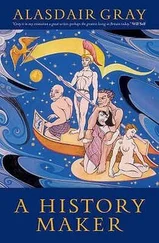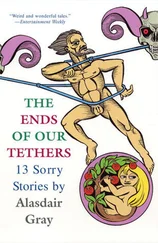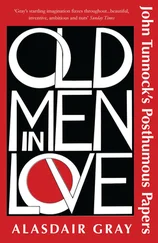He did not stop there. If this crankshaft allowed one duck to drive a vessel three times faster than normal, how much faster would two, three or ten ducks drive it? McMenamy decided to carry the experiment as far as he could take it. He constructed a craft to be driven by every one of his Granny’s seventeen ducks. It differed from the first vessel in other ways. The first had been a conventional boat shape propelled by paddles and constructed from wood. The second was cigar-shaped with a screw propeller at the rear, and McMenamy did not order it from the carpenter, but from the blacksmith. It was made of sheet iron. Without the seventeen heads and necks sticking up through holes in the hull one would have mistaken it for a modern submarine. This is a fact worth pondering. A hundred years elapsed before The Charlotte Dundas, the world’s first paddle steamer, clanked along the Forth and Clyde canal from Bowling. Fifty years after that the first ironclad screw-driven warship fired its first shot in the American Civil War. In two years the imagination of a humble cottage lad had covered ground which the world’s foremost engineers took two generations to traverse in the following century. Vague was fifteen years old when he launched his second vessel. Quacking hysterically, it crossed the pond with such velocity that it struck the opposite bank at the moment of departure from the near one. Had it struck soil it would have embedded itself. Unluckily, it hit the root of a tree, rebounded to the centre of the pond, overturned and sank. Every single duck was drowned.
In terms of human achievement, McMenamy’s duckboat ranks with Leonardo Da Vinci’s helicopter which was designed four hundred years before the engine which could have made it fly. Economic ally it was disastrous. Deprived of her ducks, McMenamy’s Granny was compelled to knit faster than ever. She sat in her rocking-chair, knitting and rocking and rocking and knitting and McMenamy sat opposite, brooding upon what he could do to help. He noticed that the muscular energy his Granny used to handle the needles was no greater than the energy she used to rock the chair. His Granny, in fact, was two sources of energy, one above the waist and one below, and only the upper source brought in money. If the power of her legs and feet could be channelled into the knitting she would work twice as fast, and his crankshaft made this possible. And so McMenamy built the world’s first knitting frame, later nicknamed “McMenamy’s Knitting Granny”. Two needles, each a yard long, were slung from the kitchen ceiling so that the tips crossed at the correct angle. The motion was conveyed through crankshafts hinged to the rockers of a cast-iron rocking-chair mounted on rails below. McMenamy’s Granny, furiously rocking it, had nothing to do with her hands but steer the woollen coils through the intricacies of purl and plain. When the McMenamys came to display their stock of caps and mufflers on a barrow in Glasgow’s Barrowland that year, the strongest knitters in the West of Scotland, brawny big-muscled men of thirty and thirty-five, were astonished to see that old Mrs. McMenamy had manufactured twice as much as they had.
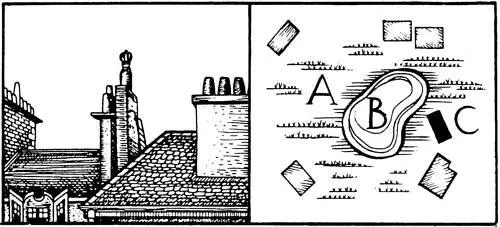
Left: Modern Cessnock shortly after implementation of the smoke abatement act.
Right: Old Cessnock from General Roy’s ordnance survey of 1739. Fig. A represents the swamp, B the duckpond, C the McMenamy hovel
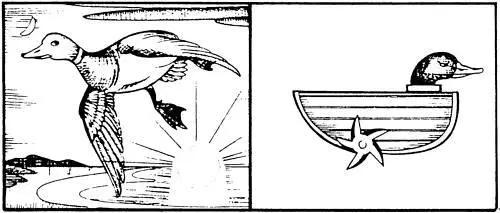
Left: Unimproved duck, after the watercolour by Peter Scott.
Right: McMenamy’s Improved Duck.
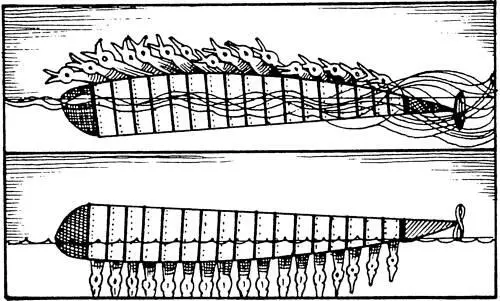
Above: McMenamy’s Improved Duck Tandem.0005 seconds after launching.
Below: McMenamy’s Improved Duck Tandem. 05 seconds after launching. (The ducks, though not yet drowned, have been killed by the shock.)
Vague, however, was modest enough to know that his appliance was improvable. The power generated by a rocking-chair is limited, for it swings through a very flattened arc. His second knitting frame was powered by a see-saw. His Granny was installed on one end with the needles mounted in front of her. Hitherto, Vague had avoided operating his inventions himself, but now he courageously vaulted onto the other end and set the mighty beam swinging up and down, up and down, with a velocity enabling his Granny to turn out no less than eight hundred and ninety caps and mufflers a week. At the next Glasgow Fair she brought to market as much produce as the other knitters put together, and was able to sell at half the normal price and still make a handsome profit. The other inhabitants of Cessnock were unable to sell their goods at all. With the desperation of starving men, they set fire to the McMenamy cottage and the machinery inside it. Vague and his Granny were forced to flee across the swamp, leaving their hard earned gold to melt among the flames. They fled to the Burgh of Paisley, and placed themselves under the protection of the Provost, and from that moment their troubles were at an end.
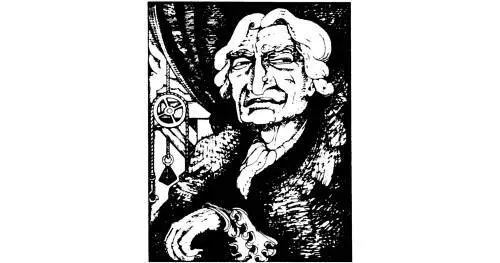
Engraving by Shanks in Glasgow People’s Palace Local History Museum showing decadence of that art before Bewick’s advent. Nobody knows if it portrays Provost Coats or McMenany’s Granny .
In 1727 Paisley was fortunate in having, as Provost, an unusually enlightened philanthropist, Sir Hector Coats. (No relation to the famous thread manufacturers of the following century.) He was moved by McMenamy’s story and impressed by his dedication. He arranged for Vague to superintend the construction of a large knitting mill containing no less than twenty beam-balance knitting the next ten years Vague spent fourteen hours a day, six days a week, swinging up and down on the opposite end of the beam from the woman who had nourished and inspired him. It is unfortunate that he had no time to devote to scientific invention, but his only holidays were on a Sunday and Sir Hector was a good Christian who took stern measures against workmen who broke the Sabbath. At the age of thirty Vague McMenamy, overcome by vertigo, fell off the see-saw never to rise again. Strangely enough his Granny survived him by twenty-two years, toiling to the last at the machine which had been named after her. Her early days in the rocking-chair had no doubt prepared her for just such an end, but she must have been a remarkable old lady.
Thirty is not an advanced age and Vague’s achievement was crowded into seven years between the ages of twelve and nineteen. In that time he invented the paddle boat and the ironclad, dealt a deathblow to the cottage knitting industry, and laid the foundations of the Scottish Textile Trade. When Arkwright, Cartwright, Wainright and Watt completed their own machines, McMenamy’s crankshaft was in every one of them. Truly, he was the crank that made the Revolution possible.

McMenamy’s tombstone, Paisley High Kirk, engraved for the 1861 edition of Samuel Smiles’s “Self Help”. (This corner of the graveyard was flattened to make way for a new road in 1911.)
Читать дальше






